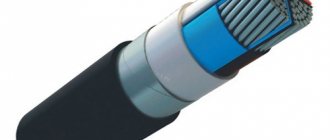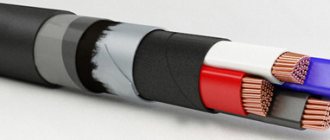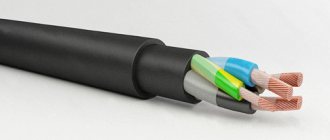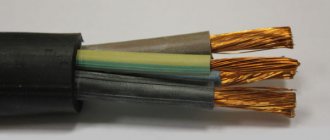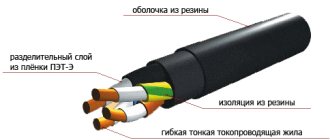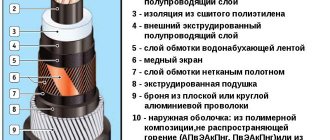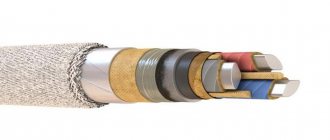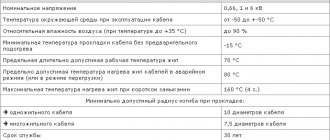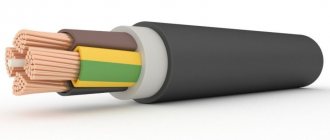Design elements and applications
| Core material A - aluminum M - copper | Insulation P - polyethylene B -PVC plastic | Shell P - polyethylene B -PVC plastic compound Vng - PVC plastic compound of reduced flammability | Protective cover |
| A | IN | absent | BbShv |
Cables of the AVBbShv brand are intended for all of the above applications (except for laying in blocks), but if there is a danger of mechanical damage during operation.
To the designation of the AVBBShV brand in the tropical version, add the letter “T” through a hyphen, for cables with single-wire conductors - the letter “ozh” in brackets, for cables in a flat version - through a hyphen, the letter “P”
Laying methods
According to the operational characteristics, highways can be installed on the basis of AVBbShV in temperate, cold and tropical climates. The latter option is acceptable with the appropriate design, which must be noted in the technical documentation and markings (the symbol “T” is added). Now about the methods of installing highways, the following options are allowed:
- When laid in the ground, such underground routes must have appropriate graphical symbols, both on the ground and on topographic and general plans. The basic laying standards can be found in Figure 6.
Rice. 6. Basic standards for underground cable laying
In addition, operational characteristics must be taken into account, in particular, permissible laying temperature, grounding organization, etc.
- Arrangement of air lines, subject to compliance with the requirements for permissible sagging and stretching.
Support for overhead cable lines AVBbShv - Laying in tunnels, channels, shafts, etc.
Laying cables in a tunnel
Laying highways in industrial and specialized premises, provided that they meet acceptable standards.
Design parameters
The number of cores in the cables, the range of nominal cross-sections of the cores and rated voltages are indicated in the table.
| Number of cores | Nominal core cross-section, mm2 | |||
| Rated cable voltage, kV | ||||
| 0,66 | 1 | 3 | 6 | |
| 2,3 and 4 | 4-50 | 6-240 | 6-240 | — |
| 3 | — | — | — | 35-240 |
For four-core cables, the largest nominal cross-section of the cores is 185 mm2.
Cables for voltages of 3 and 6 kV are made only with three cores. Two-core cables must have cores of the same cross-section. Three-, four- and five-core cables must have all conductors of the same cross-section or one conductor of a smaller cross-section (grounding or neutral conductor). Six-core cables must have four cores of equal cross-section and two wires of smaller cross-section.
The nominal cross-sections of neutral conductors (smaller cross-section) and grounding conductors must correspond to those indicated in the table.
Nominal sections of cores, mm2
| Basic | 1,5 | 2,5 | 4 | 6 | 10 | 16 | 25 | 35 | 50 | 70 | 95 | 120 | 150 | 185 | 240 |
| Zero | 1,5 | 1,5 | 2,5 | 4 | 6 | 10 | 16 | 16 | 25 | 35 | 50 | 70 | 70 | 95 | 120 |
| Grounding | 1,0 | 1,5 | 2,5 | 2,5 | 4 | 6 | 10 | 16 | 16 | 25 | 35 | 35 | 50 | 50 | 70 |
Current-carrying conductors can be single-wire or multi-wire in accordance with the table and must comply with classes 1 and 2.
| Core name | Nominal core cross-section, mm2 | |||
| round | shaped | |||
| copper | aluminum | copper | aluminum | |
| Solid wires | 1,0-50 | 2,5-240 | 25-50 | 25-240 |
| Stranded cores | 16-240 | 25-240 | 25-240 | 25-240 |
The current-carrying conductors of single-core cables of all cross-sections and multi-core cables with a cross-section of up to 16 mm2 must be round in shape. Conducting conductors of belt-insulated cables with a cross-section of 25 mm2 or more must be sector or segment shaped.
The radius of curvature of single-wire sector cores must be at least 0.5 mm.
It is allowed to manufacture cables with round conductors with a cross-section of up to 50 mm2.
The conductors are insulated, depending on the brand, with PVC plastic or polyethylene. The current standard provides for insulation made of cross-linked polyethylene (designation Pv).
The insulated cores of multi-core cables must have a distinctive color. The insulation of the neutral conductors should be blue (light blue).
The insulation of the grounding conductors must be two-color (green-yellow), with one color covering at least 30 and no more than 70% of the insulation surface, and the other the rest.
The color marking must be continuous or in the form of a longitudinal stripe with a width of at least 1 mm.
It is allowed to mark cores insulated with polyvinyl chloride plastic with numbers, starting from zero. Marking with numbers is done by embossing or printing. The height of the numbers is at least 4.0 mm. The distance between numbers should not be more than 35 mm.
The insulation of single-core cables can be of any color.
Cable insulation thickness, mm
| Rated voltage, kV | Nominal core cross-section, mm2 | Insulation made of polyethylene or polyvinyl chloride plastic | XLPE insulation |
| 0,66 | 1-2,5 | 0,6 | 0,7 |
| 4 and 6 | 0,7 | 0,7 | |
| 10 and 16 | 0,9 | 0,7 | |
| 25 and 35 | 1,1 | 0,9 | |
| 50 | 1,3 | 1,0 | |
| 1 | 1-2,5 | 0,8 | 0,7 |
| 4-16 | 1,0 | 0,7 | |
| 25 and 35 | 1,2 | 0,9 | |
| 50 | 1,4 | 1,0 | |
| 70 | 1,4 | 1,1 | |
| 95 | 1,5 | 1,1 | |
| 120 | 1,5 | 1,2 | |
| 150 | 1,6 | 1,4 | |
| 185 | 1,7 | 1,6 | |
| 240 | 1,9 | 1,7 | |
| 3 | 6-240 | 2,2 | 2,0 |
| 6 | 10-240 | 3.0 - for polyethylene | 3,0 |
| 3.4 - for polyvinyl chloride plastic compound |
Twisted insulated conductors must have gaps between them filled.
It is allowed to manufacture cables without tapes over twisted insulated cores, provided that the mobility of the insulated cores is maintained and the sheath can be separated from the insulation without damaging it.
The belt insulation must be pressed out of the insulation material or from polyvinyl chloride plastic compound or applied by winding or longitudinally with strips of polyethylene terephthalate film, polyvinyl chloride plastic compound or other equivalent material.
For cables with voltages up to 3 kV inclusive, belt insulation consisting of two strips of polyethylene terephthalate film and two strips of crepe paper is allowed.
The nominal thicknesses of PVC shells must correspond to category Obp-2
Reference values of outer diameters and weights of cables of individual standard sizes are indicated in the tables
Taking into account significant tolerances, actual values may differ by 5-10% down or up.
On the plastic sheath or protective hose, no more than every 300 mm, the distinctive index of the manufacturer and the year of manufacture of the cable must be applied.
How to decipher the markings
Each manufacturer applies product markings to the external insulation. For this, a special printer or hot stamping method can be used. The decoding of the marking is standard and corresponds to GOST.
Explanation of the AVBBSHV cable:
- “A” - the core is made of aluminum;
- “B” - polyvinyl chloride insulation is used;
- “B” - armor using steel strips;
- “b” - absence of a protective cushion between the cores and the armor;
- “Shv” is the outer sheath of PVC hose.
The description following the letters is deciphered as the number and cross-sectional size of the cores. For example, 3x35 means the presence of three cores, each of which has a cross-section of 25 mm². Additional value allowed: 3x25 + 1x16. This means that the conductor uses 3 main cores and 1 neutral circuit with a cross-section of 16 mm².
Electrical Requirements
The cables must withstand an alternating voltage test with a frequency of 50 Hz for 10 minutes. The test voltage values are given in the table.
| Rated cable voltage, kV | Test voltage value |
| 0,66 | 3 |
| 1 | 3,5 |
| 3 | 9,5 |
| 6 | 15 |
Electrical insulation resistance of cables, MOhm
| Core cross-section, mm2 | Electrical resistance, MOhm |
| With PVC insulation for voltage 0.66 and 1 kV | |
| 1 and 1.5 | 12 |
| 2,5-4 | 10 |
| 6 | 9 |
| 10-240 | 7 |
| With PVC insulation for voltage 3 kV | |
| 1 — 240 | 12 |
| With PVC insulation for voltage 6 kV | |
| 1 — 240 | 50 |
| With polyethylene insulation | |
| 1 — 240 | 150 |
Manufacturers
Today, many people produce VBBShV copper cable, but in order to avoid becoming a victim of counterfeiting, we recommend giving preference to the following manufacturing plants:
- Kolchuginsky plant;
- Kavkazcable;
- Sevkabel;
- Pskovkabel;
- Kamkabel;
- Energy cable;
- Uralcable.
These manufacturers VBBShV have the highest quality products. Many professionals trust these factories and leave positive reviews about the reliability of cable products. If you doubt that the conductor you purchased does not meet the standards, we recommend checking the thickness of the current-carrying conductors and insulation. We talked about how to determine the cable cross-section in the corresponding article!
That's all I wanted to tell you about the technical characteristics of the VBBShV cable. We hope you now know where it is used and how to decipher this conductor!
We also recommend reading:
- Installation of electrical wiring in the bathhouse
- How to make an LED spotlight with your own hands
- How to install electricity in a barn
Outer diameters of cables for voltage 0.66 kV, mm
| Nominal core cross-section, mm2, nx S | AVBbShv |
| 2x4 | 15 |
| 2x6 | 16 |
| 2x10 | 19 |
| 2x16 | 20 |
| 2x25 | 24 |
| 2x35 | 26 |
| 2x50 | 29 |
| 3x6 | 16 |
| 3x10 | 17 |
| 3x16 | 19 |
| 3x25 | 21 |
| 3x35 | 25 |
| 3x50 | 31 |
Looking for the right solution
Today, the product line of power cable products has an extensive range. They are designed to operate in industrial-grade electrical networks. These products are characterized by low flexibility and are designed for voltages from 0.4 kV to 10 kV. They differ from each other in their technical parameters and characteristics. For example, the ability to transmit electricity in aggressive conditions and fire hazardous areas. They also differ in their design features. Therefore, before connecting the electrical installation to the electrical network, a question arises. How to choose the right cable?
Recently, experts have recommended opting for armored cables. According to their characteristics and designs, they are more reliable in operation and do not require special conditions during the installation process. This series includes cables AVBShv and AVBbShv. But what is their difference? What are the technical specifications and what are the installation requirements?
AVBbShv
Weights of cables for voltage 0.66 kV, kg/km
| Nominal cross-section of cores, mm2 | AVBbShv |
| 2x4 | 320 |
| 2x6 | 360 |
| 2x10 | 460 |
| 2x16 | 550 |
| 2x25 | 700 |
| 2x35 | 810 |
| 2x50 | 1050 |
| 3x4 | 360 |
| 3x6 | 400 |
| 3x10 | 520 |
| 3x16 | 630 |
| 3x25 | 830 |
| 3x35 | 1000 |
| 3x50 | 1300 |
Outer diameters of cables for voltage 1 kV, mm
| Nominal cross-section of cores, mm2 | AVBbShv |
| 2x6 | 17 |
| 2x10 | 19 |
| 2x16 | 21 |
| 2x25 | 24 |
| 2x35 | 26 |
| 2x50 | 30 |
| 3x6 | 18 |
| 3x10 | 20 |
| 3x16 | 22 |
| 3x25 | 25 |
| 3x35 | 28 |
| 3x50 | 31 |
| 3x70 | 33 |
| 3x95 | 37 |
| 3x120 | 40 |
| 3x150 | 44 |
| 3x185 | 47 |
| 3x240 | 53 |
Weights of cables for voltage 1 kV, kg/km
| Nominal cross-section of cores, mm2 | AVBbShv |
| 2x6 | 400 |
| 2x10 | 470 |
| 2x16 | 560 |
| 2x25 | 720 |
| 2x35 | 850 |
| 2x50 | 1050 |
| 3x6 | 460 |
| 3x10 | 540 |
| 3x16 | 650 |
| 3x25 | 850 |
| 3x35 | 1000 |
| 3x50 | 1300 |
| 3x70 | 1600 |
| 3x95 | 2000 |
| 3x120 | 2300 |
| 3x150 | 2700 |
| 3x185 | 3200 |
| 3x240 | 3900 |
terms of Use
Permissible operating temperatures, °C
| Type of cable insulation | Long-term permissible core heating temperature | Maximum permissible temperature at short circuit currents |
| Polyvinyl chloride plastic compound | 70 | 160 |
| Polyethylene | 70 | 130 |
| Cross-linked polyethylene | 90 | 250 |
The shelf life of cables in open areas is no more than 2 years, under a canopy - no more than 5 years, in enclosed spaces - no more than 10 years.
Typical installation errors
Acceptable errors when using cable AVBbShv
- Before you buy an expensive armored cable, study the conditions of the facility that needs to be provided with power, all possible methods, the required power, cross-section and other parameters. If there is no way to install the cable by air in cable ducts, where the possibility of gross unauthorized mechanical impact is excluded, then only lay AVBbShv underground.
- Be sure to connect the armored sheath to the ground loop on both sides of the cable;
- It is recommended to seal the cable ends at the connection points hermetically, using epoxy funnels or rubber gloves with heat-shrinkable tapes. This must be done even in heated rooms; cables tend to draw condensation from the air under the insulating layer. Accumulation of moisture can cause arcing of the insulation and short circuit.
- Do not connect the ends of the cores to the RU busbars without crimped factory lugs. Clamping the end of the wire tucked around the bolt between the busbar and the washer does not provide the quality of contact as the factory tip. Poor contact burns out at high currents.
- Technical characteristics of the ASB cable
- Technical characteristics of PV-1 wires
- Overview of NYM cable technical characteristics, applications and manufacturers
- Wire PV-3: technical characteristics, scope, manufacturers
- Application, technical characteristics and installation of RKGM wire
